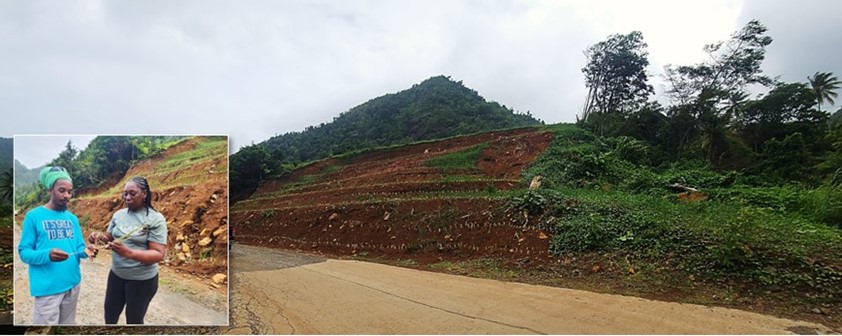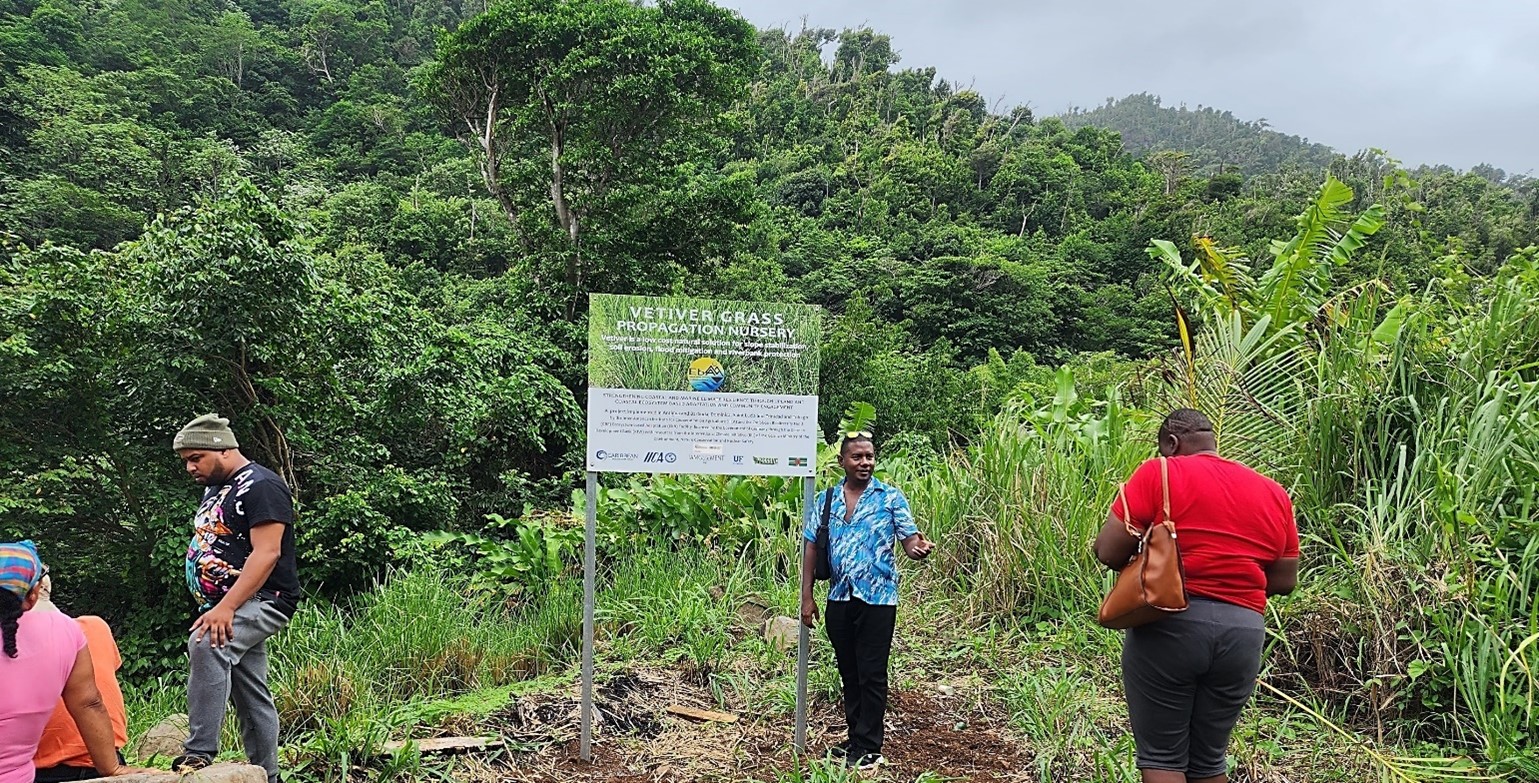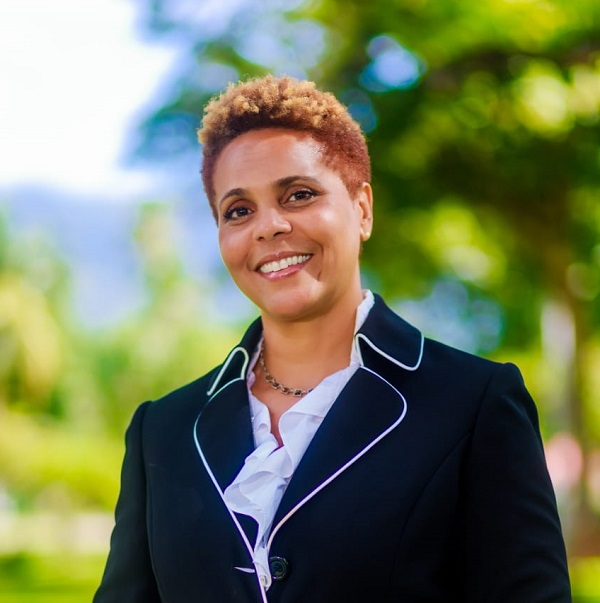
Panoramic view of east coast of Dominica from the Rosalie Bay Resort, venue of the EbA Project Closing Symposium (Photo: EbA Project).
Change is inevitable. Exposure to impacts is inescapable.
Readiness to adapt and recover quickly is invaluable.
|
“Caribbean Nations Unite for Climate Resilience: Ecosystem-Based Adaptation Triumphs Over Challenges” |
From 3rd to 5th July, a group from Antigua, Dominica, St. Lucia, Trinidad and Tobago met to exchange experiences, learn lessons and discuss ‘what next’ in ecosystem-based adaptation (EbA) at a Symposium marking the closing process of a climate action project. This project, to strengthen coastal and marine ecosystem climate resilience using EbA and nature-based solutions (NbS), is funded by the Caribbean Biodiversity Fund (CBF) EbA Facility and implemented by the Inter-American Institute for Cooperation on Agriculture (IICA) and partners, including community-based organisations.
The venue, the east-coast, eco-friendly Rosalie Bay Resort, a breezy, natural and green environment, embodied the theme of the meeting, ‘for the planet, for the people’. The anxieties and risks associated with organising a regional event during the hurricane season, and more so in Dominica, known for its unpredictable rainfall, thankfully, did not materialize. But even if they did, this would basically be life on a changed climate of planet Earth. The weather was bright and beautiful, allowing visitors and locals alike, to proceed as planned on project site visits. But in case there was any doubt about climate change, nature reminded us that it is already happening. These three days were not just unbelievably hot, but heavily humid despite the constant sea breeze.
The week of 3rd July 2023 was reported as the hottest ever on record since 1979, and according to more recent reports, perhaps breaking a record that goes back many hundreds, if not thousands of years (Gavin Schmidt, Director, NASA Goddard Institute for Space Studies 21 July 2023). The Symposium was also taking place during the Hurricane Season, and top of mind was also Dominica's destructive tropical weather systems: Hurricane David, a strong Category 4, late in August 1979, the most destructive hurricane in more than 150 years to impact Dominica. According to the media then, Dominica, known as a green island, had turned grey overnight. Fast forward to 2015's Tropical Storm Erika and 2017's Category 5 Hurricane Maria, where the green island, turned grey overnight, again! Back in 1979, no one was talking about climate change, at least not in Dominica.
Change is inevitable, but fast-tracked by humans
‘Climate change’, ‘climate crisis’, ‘climate catastrophes’ are frequently used terms in the media, by policymakers and more recently, by the average community dweller. However, not everyone has a common perspective on what these terms mean and how they impact their respective lives, livelihoods and situations. This is part of the problem why there is no unanimous consent for climate action, or even what the focus of climate action should be. A May 30th, 2023, interview on the CBS Sunday Morning show, quoted Arnold Schwarzenegger as saying that ‘as long as they keep talking about global climate change, they are not gonna go anywhere. Cause no one gives a s--- about that’. He continued, ‘we’re talking about pollution. Pollution creates climate change, and pollution kills’. I am left wondering who is the 'they' that is being referred to; should it now be 'we'?
|
“Understanding Climate Terms Crucial for Unified Action: Shifting Focus from Jargon to Impactful Change” |

Site of the major landslide in Dominica due to intense early November 2022 rainfall, where community opinions link the slide to poor road/water drainage planning in a landscape that epitomizes ridge-to-reef (Photo: EbA Project).
|
“Fighting Pollution and Building Resilience: Caribbean Islands Embrace EbA and Nature-Based Solutions” |
Pollution is, indeed, a human phenomenon, the products and outcomes of poor human decisions, choices and practices on how we utilise and interact with the natural environment and its resources. This is why, for the most part, ‘climate change’ is described as ‘anthropogenic’, i.e., caused by humans. Evidence of this can be found in communities in the four Caribbean islands that were the focus of the IICA-CBF EbA project. For mountainous islands like Dominica, St. Lucia, and Tobago, clearing of forests, farming on slopes and land development on hillsides, have all contributed to soil erosion and heavy sedimentation run-off via rivers which pollute coastal and marine environments. More intense rainfall due to climate change has made it worse. Antigua does not have steep slopes nor high rainfall. However, in the Cooks Landfill, the main receiving area for disposal of wastes due to human activity, soil erosion channels toxic residue and leachate into the neighbouring fragile mangrove ecosystem. This is a major environmental concern.
Ecosystem-based adaptation (EbA) solutions and practices must feature prominently in island climate resilience actions. The IICA-CBF EbA project’s main EbA tools were climate-smart agriculture (CSA) and the vetiver grass. Most of us in agriculture are familiar with the CSA concept and practices; using vetiver grass as a good, nature-based solution was a forgotten culture. NbS are essentially pitched as a ‘good fit’ and a ‘go to’ in the climate action toolkit, as they work with and enhance nature’s inherent ability to mitigate impacts and adapt to climate change (Truong and Loch 2004; Truong 1999). The vetiver grass promoted as a ‘good fit’ and ‘go to’ tool to help mitigate soil erosion and its consequent impact, is now being described as the ‘good grass’ by June Jackson of the Gilbert Agricultural Rural Development Centre (GARDC) in Antigua, one of the project’s most active stakeholders. This is because its deep roots hold soils together and its roots and leaves provide raw material to create home décor, bath, body and other craft products to build livelihoods.

A site located in Petite Soufriere receiving the ‘good grass’ (vetiver) treatment, as described by project stakeholder, June Jackson from Antigua as she engages with project stakeholder, Elijah Charlemange from St. Lucia. (Photo: EbA project).
|
“Utilizing nature or ecosystem-based solutions is vital in addressing the severe environmental degradation caused by decades of poor practices.” |
NbS … working with and enhancing nature
What is the benefit of using nature or ecosystem-based solutions in an environment so badly degraded by decades of poor practices that have severely weakened the regenerative capacity of natural systems. In speaking at the Symposium, Director of Agriculture in the Ministry of Agriculture, Blue and Green Economy, Dominica, Ricky Brumant, listed a number of elements of a P-point action agenda for mainstreaming EbA/NbS/CA in climate resilience. According to Brumant, Dominica is ‘a beautiful country, with over 200 shades of green; but God gave us slopes and a lot of rain. But he also gave us a plant that can be used to help keep the slopes intact, based on our practices as stewards of our environment’. The plant is the deep-rooted vetiver grass. His essential message is the need to be aware of our practices as stewards of our environment and to not discount the power of nature-based solutions in our climate action toolkits.
The hurricanes and tropical storms referred to earlier, that impacted Dominica have at least three things in common: they are inherent and inevitable elements of the natural world; being impacted by them is almost unavoidable; and the citizens of Dominica were massively unprepared in each case. These natural weather systems have intensified due to climate change and have become less predictable. In small island states, the impacts are more extreme due to higher levels of exposure and socio-economic vulnerabilities. Small island states are on an urgent drive to resilience. However, resilience is not a static state. Once an acceptable level is achieved, there is need for continuous actions to keep the resilience equilibrium in balance, evidenced by the ability to recover faster after each subsequent impact.
According to the CBFs Climate Change Program Manager, Dr. Ulrike Krauss, EbA Facility projects are designed to ‘sustainably manage EbA-supporting marine and coastal zone habitats, including rehabilitating key, high-value ecosystems, and incorporating social and economic resilience to climate change.’ She noted that the ‘EbA always has three pillars: (1) conservation of biodiversity and ecosystems, (2) making use of ecosystems for climate change adaptation, and (3) making use of ecosystems for socioeconomic benefits. Only when all these three pillars are all there and in balance, then there is a true EbA project.’ Nature-based solutions and practices are essential to all three pillars.
|
“Ultimately, nature-based solutions are fundamental to achieving a balanced and effective strategy for climate resilience.” |

Vetiver nursery established through the project in Petite Soufriére, Dominica, as a good practice to provide a safe and secure supply of plants for geoengineering, is transitioning into a green business under the brand ‘Nature’s Nursery’ (photo EBA Project).
Sustaining conservation and resilience actions is not free; it requires resources, human action, human motivation and the opportunity to earn a decent living to sustain good practices. This is where the issue of mainstreaming becomes imperative and should absolutely meet the 3 pillars of the EbA principle as emphasised by Dr. Krauss. In the last six to nine months of the IICA-CBF EbA project, the focus has been on ensuring balance among the three EbA pillars, in particular pillar 3, making use of ecosystems for socioeconomic benefits. This project takes a direct and focused approach to green business. It has been training and providing business development support to help community dwellers to build decent livelihoods from the grass itself, as a base raw material, adding value to the roots and leaves to craft, home décor, health and wellness products, among others, and the plant for landscaping and geoengineering services, i.e., pillar 3. This support includes ensuring that these businesses are formally registered and provided with the knowledge and tools to survive and grow post-project.
|
“Sustaining conservation and resilience efforts requires resources, human involvement, motivation, and the ability to earn a living.” |

Collection of vetiver-based value-added products produced by beneficiaries trained in handicraft under the project (photo EBA Project)
Mainstreaming island climate resilience; after projects
Projects are necessary and important vehicles for development. But they are far from sufficient and can have limited impact based on the scale of the problem. Global climate change is definitely a huge problem attracting several projects, some with very similar objectives and activities, funded by several donors. The IICA-CBF EbA project is itself, funded under a CBF project – the EbA Facility, that is due to end in roughly two years. The establishment of the EbA Facility in 2016 under the Climate Change Programme of the CBF was timely. The EbA Facility is a sinking fund in the amount of US 50 million provided by the German Federal Ministry for the Environment, Nature Conservation, Nuclear Safety and Consumer Protection (BMUV), through projects under the International Climate Initiative (IKI). The CBF is an umbrella environmental fund to mobilise resources and financing for climate action projects in the Caribbean.
|
“The emphasis is on a holistic and long-term approach rather than solely relying on individual projects” |
As stated by Samuel Carrette of the Climate Resilience Execution Agency of Dominica, (CREAD) at the EbA project Symposium, ‘projects were introduced in the development arena largely in the 1970s and 1980s and used heavily as a vehicle to deliver development products, but a fundamental issue of projects is how they are so defined and yet so confined’. He continued by admitting that ‘on reflection 20 years later, while projects are very important, we also have to pay attention to issues of sustainability, resilience, capacity, and the needs of both the target sector and other complementary sectors.’ On the issue of mainstreaming resilience, Carrette also advised that it is necessary with and without, to ‘inform yourselves, in terms of the mechanisms of addressing some of the problems created by the climate change crisis.’
Access to climate financing is essential to countries like those participating in the IICA-CBF EbA project. In global climate change talks, small island states are now referring to themselves as ‘big ocean islands’. It is estimated that they contribute less than 0.2 % of global carbon emissions and yet are on the receiving end of the injustices of catastrophic climate impacts, with limited resources to rehabilitate and recover, to ensure growth and build resiliency. On the matter of climate financing, Theresa Sanderson, of the CBF, alerted participants at the Symposium of a mechanism of ‘perpetual financing’ pursed by the CBF through management of an Endowment Fund for 11 Caribbean countries. Interest generated from this fund can be utilised by National Conservation Trust Funds (NCTFs) to provide grants based on their country’s established priorities and sectors. The endowment fund is itself, supported by specific governments through specific projects. However, as indicated by Sanderson, ‘this innovative mix of endowment and projects is a good model for ensuring that conservation financing is not always looking for the next donor or depending on the next project.’
In terms of what next, Gregg Rawlins, IICA Representative in the Eastern Caribbean States, summed it up by saying that the EbA project closing symposium ‘provides a very important platform for us to collectively consider how we sustain some of these actions moving forward, especially as too often we Implement projects that are well intended, with very laudable objectives but when the project comes to an end, that's also the end of the activity. There is a need to continue the conversation about sustaining these actions moving forward, so, that down the road, one could still see activities that are ongoing, activities that have been inspired, activities that are making an impact based on these interventions.’
 Diana Francis is a graduate of the University of the West Indies (UWI), St. Augustine – BSc. Economics (1986-1989) and Cave Hill - MPhil Economics (1993-1996). She has been working in agricultural and rural development, providing policy and trade support since 1989, at the national level through the Ministry of Agriculture in Dominica, and from 1993, at the regional level, with the Inter-American Institute for Cooperation on Agriculture (IICA). She has provided direct support to CARCOM and the OECS Secretariat, and individual Ministries of Agriculture, in formulating Agricultural Policy and Strategy, emphasizing the importance of rebuilding strong planning capacity for effective policy implementation. She has authored/co-authored a number of publications and written pieces on a range of topics in agricultural development as well as develop and manage implementation of externally funded regional projects. As the current IICA Representative in Trinidad and Tobago (from July 2019), she manages IICA’s technical cooperation activity in collaboration with a number of strategic partners in areas related to climate resilience, agricultural health and food safety, community-based agriculture and rural development, food and nutrition and importantly, providing coordinated and holistic development support to micro and small agro-processors.
Diana Francis is a graduate of the University of the West Indies (UWI), St. Augustine – BSc. Economics (1986-1989) and Cave Hill - MPhil Economics (1993-1996). She has been working in agricultural and rural development, providing policy and trade support since 1989, at the national level through the Ministry of Agriculture in Dominica, and from 1993, at the regional level, with the Inter-American Institute for Cooperation on Agriculture (IICA). She has provided direct support to CARCOM and the OECS Secretariat, and individual Ministries of Agriculture, in formulating Agricultural Policy and Strategy, emphasizing the importance of rebuilding strong planning capacity for effective policy implementation. She has authored/co-authored a number of publications and written pieces on a range of topics in agricultural development as well as develop and manage implementation of externally funded regional projects. As the current IICA Representative in Trinidad and Tobago (from July 2019), she manages IICA’s technical cooperation activity in collaboration with a number of strategic partners in areas related to climate resilience, agricultural health and food safety, community-based agriculture and rural development, food and nutrition and importantly, providing coordinated and holistic development support to micro and small agro-processors.
Note: The opinions expressed in this article are the responsibility of the authors and do not necessarily reflect the opinion of IICA.
|
If you have questions or suggestions for improving the BlogIICA, please write to the editors: Joaquín Arias and Eugenia Salazar. |
Añadir nuevo comentario